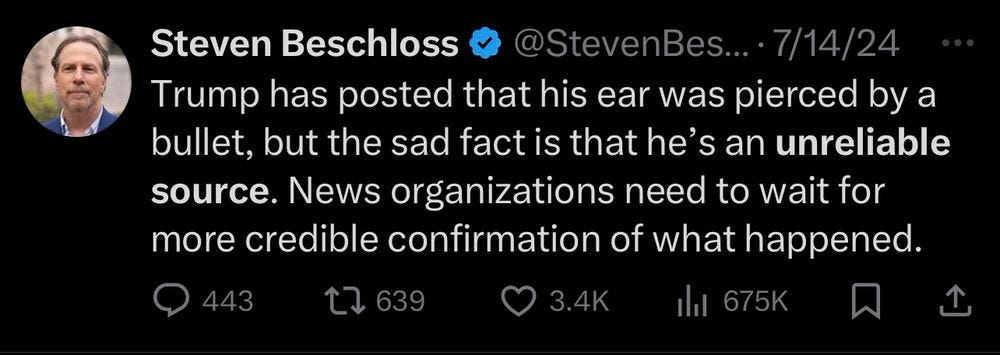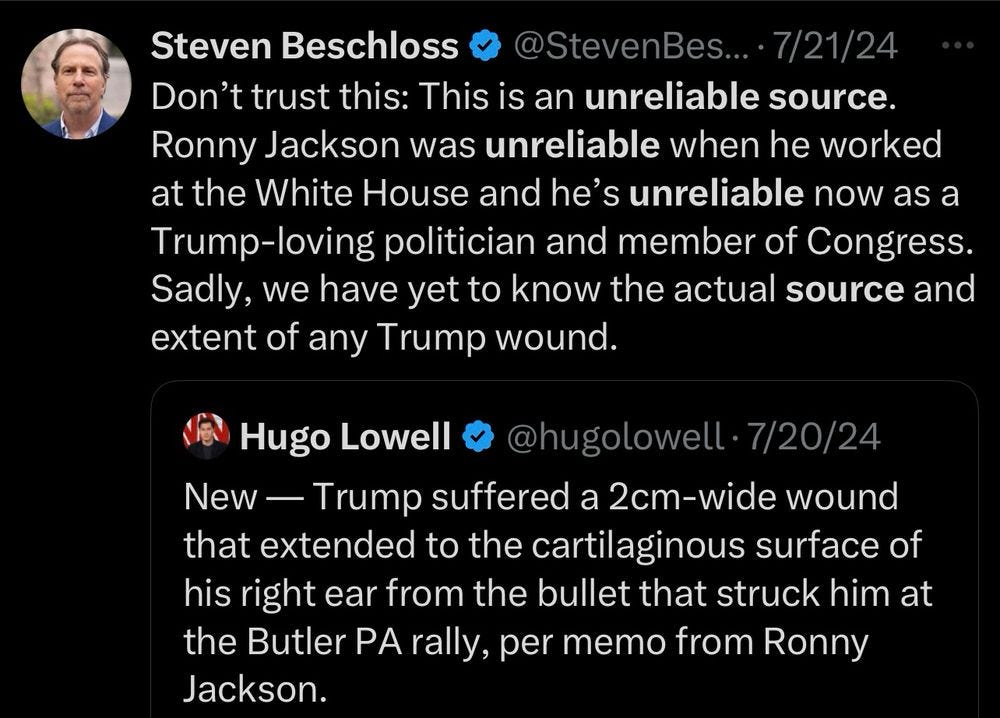Snapshot: The Ear, The Fear, The Facts Denied
Reflecting on the assassination attempt a year ago

I wrote a book about Lee Harvey Oswald—who he was and why he would assassinate President John F. Kennedy. That November day in Dealey Plaza in Dallas, Texas has been pored over in excruciating detail as writers have sought to make sense of that world-altering tragedy. Six decades on, it remains a troubling vortex for conspiracy theorizing.
So you can imagine my surprise when the assassination attempt of Donald Trump a year ago in Butler, Pennsylvania was so quickly glossed over. Were we really not going to learn more about the shooter? Did the strange behavior of the Secret Service allowing Trump to stand up, show his face, fist pump and shout “fight, fight, fight” make any sense? And was he hit by a bullet or a shard of glass or what?
Understandably, there are skeptics who wonder whether the whole event was staged. The gross and extensive way that Trump exploited this shooting surely added fuel for the conspiracy-minded. Yet count me among the doubters who—as much as I believe Trump would do anything to grab power—recognize the complexity of pulling off an operation like this. It would assume total buy-in and every actor performing his job without error; that’s usually where the logic of large-scale conspiracies breaks down.
But I think it’s worth pausing to note how that event illustrates Trump’s success at denying the public knowledge and likely exploiting the Biden Administration’s fear of escalating violence. That brings me to Trump’s ear and—to this day—a lack of reliable information from a medical professional who was present to explain what happened.
As I noted on X a year ago, on July 14, we surely couldn’t rely on Trump:
And even a week later, on July 21, we were stuck with the unreliable summary of his former White House doctor, Ronny Jackson, who released a memo to “Concerned Citizens of the United States.” As I observed:
Days earlier, Trump showed up at the Republican National Convention with a large bandage over his right ear, clearly determined to emphasize the shooting. It was effective myth-making, particularly when Republicans arrived with their own ear bandages to highlight their solidarity with Trump.
In his July 18 speech, Trump underlined the source of his wound. “It can only be a bullet,” he told the crowd. And, “if I had not moved my head at that very last instant, the assassin’s bullet would have perfectly hit its mark and I would not be here tonight.”
But a week later, on July 24, FBI Director Christopher Wray told a House Judiciary Committee, “There’s some question about whether or not it’s a bullet or shrapnel that hit his ear.”
The next day Trump snapped back at Wray on Truth Social for doubting him: “No, it was, unfortunately, a bullet that hit my ear, and hit it hard. There was no glass, there was no shrapnel. The hospital called it a ‘bullet wound to the ear,’ and that is what it was.”
That’s what Trump said—and the next day the FBI released this statement that backtracked: “What struck former President Trump in the ear was a bullet, whether whole or fragmented into smaller pieces, fired from the deceased subject’s rifle.” A Washington Post report that same day included the observations of several trauma surgeons who were shown photos and video of the shooting suggesting that “Trump’s injury appears to be consistent with the attributes of a graze wound from a bullet.” (Emphasis is mine.)
But here’s the thing: The medical team that treated Trump at Butler Memorial Hospital was not made available to share the details of the wound or his care. There was no press conference. There were no hospital records of his treatment released. As Time magazine noted last year on July 26, “Trump’s team has largely remained tight-lipped about the ear wound.” (A month after the shooting, journalist Olivia Nuzzi inspected Trump’s ear during a sit-down interview for New York Magazine and reported that it looked “normal” and “fine,” adding, “An ear had never appeared to have gone through less.”)
A year on—as we confront the reckless destruction of our government, the expansion of a fascist police state, and daily attacks on human decency and sanity itself—the question of Trump’s ear is far from our highest priority. (A report about the shooting was released over the weekend, addressing “unacceptable failures” by the Secret Service, but firing no one.)
Yet while I have no interest in advancing conspiracy theories about the Butler shooting, we should remember Trump’s aggressive response to that day’s events as the actions of an anti-democratic authoritarian who was determined to control the narrative, take maximum benefit to serve his return to power, silence dissent from anyone who questioned what happened and deny the public the ability to assess the truth. It’s a pattern that we will continue to suffer over and over in the months and years ahead.
Please consider becoming a paid subscriber for $50 a year or just $5 a month, if you’re not already. This helps sustain and expand the work of America, America, keeps nearly all the content free for everyone and gives you full access to the comment sections. Building our community has never been more important.




And this is another example of main stream media dropping the ball, fearful of a backlash from those ready to pounce on perceived "liberal bias."
We're all afraid to go down a rabbit hole resulting in accusations of lunacy. BUT, the whole scene seemed too "perfect." The blood perfectly placed on the face. The hero arising from the depths..."fight, fight,fight." Fist raised in defiance. And where the hell were hospital officials with a report, to include other probable injuries,such as inner ear damage or a concussion? I mean,come on man! I'll say no more.
Doesn’t this feel like ancient history, Steven. I’m still not sure about any of it though. But now that the country is in peril it has taken on more importance as a harbinger of what was to come. Performative politics by the Shadow Docket.